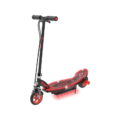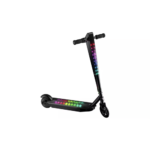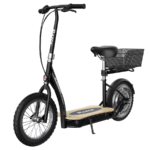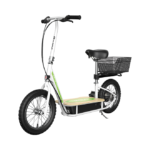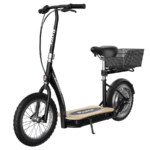- Home
- Scooters
- Electric Scooters
- Razor EcoSmart SUP
Razor EcoSmart SUP
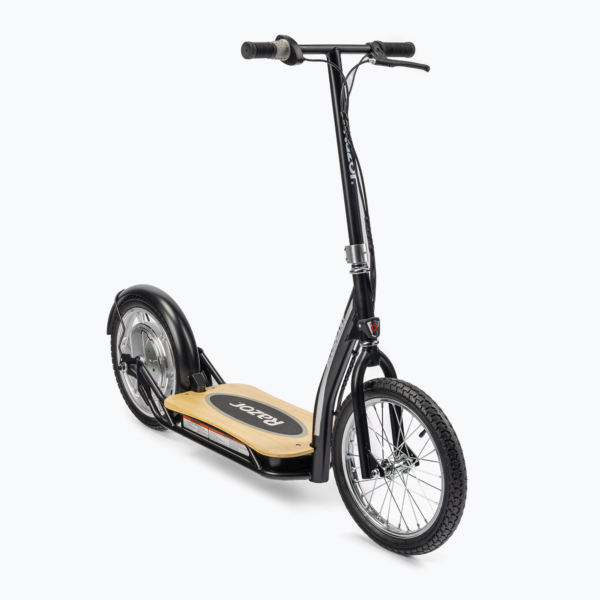

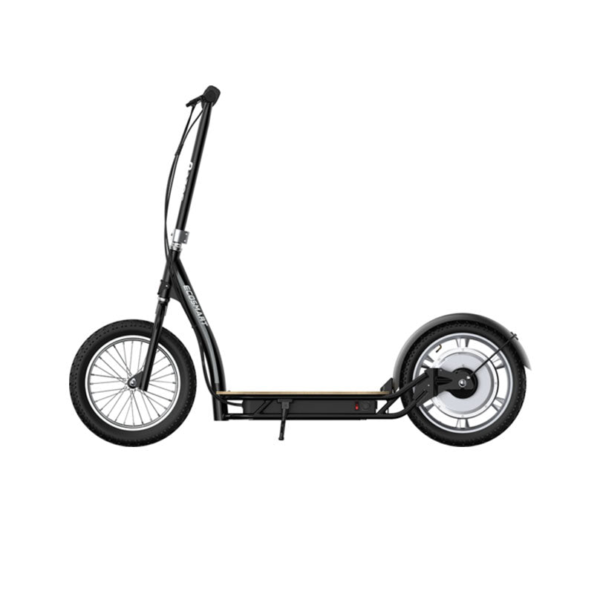
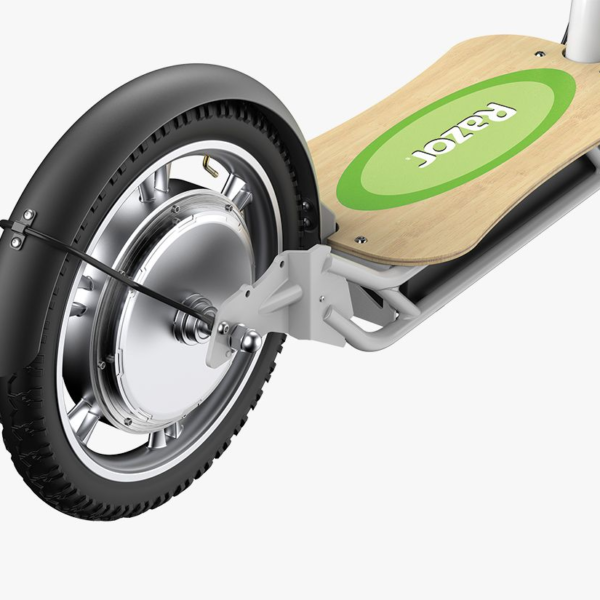
- Battery Range: 12 mi (19 km)
- Top Speed: 15.5 mph (25 km/h)
- Motor Power: 350 W nominal (hub drive)
- Weight Capacity: 220 lb (100 kg)
- Charging Time: ~6 h
- Scooter Weight: 63.0 lb (28.6 kg)
PROS
- Stand-up platform + big wheels
- Stable, calm tracking at speed
- Simple, low-maintenance drivetrain
- Bright lighting and reflectors
- Easy storage and charging indoors
CONS
- Heavier than small-wheel commuters
- Pneumatics need pressure care
- Large folded footprint
- Top speed modest by design

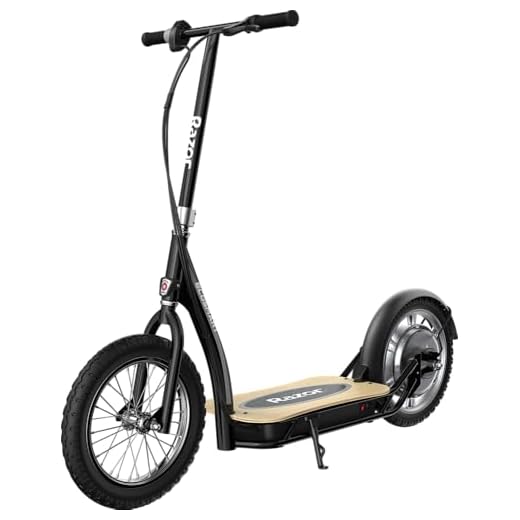
Table of contents
- What Is the Razor EcoSmart SUP?
- How the Razor EcoSmart SUP Works
- Key Specifications
- Design & Build Quality
- Performance Fundamentals
- Battery, Range & Efficiency
- Ride Quality & Comfort
- Braking & Safety Features
- Portability & Daily Usability
- Maintenance & Care
- Weather & Seasonal Considerations
- Razor EcoSmart SUP vs Alternatives
- Who the Razor EcoSmart SUP Is (and Isn’t) For
- FAQs
- Glossary
- Final Thoughts
The Razor EcoSmart SUP is a big-wheel, stand-up electric scooter built for relaxed neighborhood travel and easy errands. It blends a wide bamboo deck with bicycle-size tires, so rides feel stable even on imperfect pavement. Because it favors comfort and simplicity, it suits new riders, returning riders, and anyone who values a smooth roll over maximum speed.
What Is the Razor EcoSmart SUP?
The Razor EcoSmart SUP is the stand-up sibling to Razor’s seated EcoSmart family. Instead of a saddle and basket, you get a clean cockpit, a roomy bamboo platform, and 16-inch pneumatic tires that float over cracks and seams. The motor is mounted in the rear wheel, and power comes from a 36-volt battery pack designed for predictable, steady output.
Unlike many compact commuter scooters, the SUP does not fold. That choice keeps the frame simple and sturdy. It also gives the deck area more space, which helps with stance adjustments and comfort during longer rides. Because of its large, bicycle-like wheels and rear-wheel drive, the scooter tracks straight and feels confidence-inspiring at neighborhood speeds.
How the Razor EcoSmart SUP Works
At a glance, the EcoSmart SUP uses a classic e-scooter recipe, but with a few big-wheel twists.
Motor. The rear hub motor provides direct drive to the back wheel. There’s no chain to tension or belt to align. As a result, power delivery is quiet and linear. Think of it like a gentle push from behind that increases as you roll on the throttle.
Controller. The controller sits between the battery and motor and meters power based on your throttle input. It’s tuned for smooth starts rather than snap. Consequently, it helps newer riders avoid jerky launches in crowded areas or on wet pavement.
Battery. A 36-volt system powers the scooter. The pack is built for dependable neighborhood use and favors stable output over ultralight weight. In practice, you’ll notice consistent power at low to moderate speeds, especially on level ground.
Throttle. A twist-grip throttle on the right handlebar handles acceleration. The feel is familiar to anyone who has used a bicycle grip shifter. Roll it gently to start, then add more twist to pass or climb. Because it’s analog, you can feather power on rough surfaces and avoid wheel spin.
Brakes. A hand-operated rear brake provides straightforward control with predictable bite. Squeeze gently for speed checks, then increase pressure for quick stops. Since the large 16-inch pneumatic tires add grip, braking feels planted, not twitchy.
Put together, these parts create an easygoing ride: push off, roll on the throttle, and cruise. You don’t need a performance mindset to enjoy it. Instead, you get a forgiving platform that emphasizes control, comfort, and simplicity.
Key Specifications
Note: Values below reflect manufacturer information and common real-world observations. Where the scooter does not fold, “folded dimensions” match the assembled footprint.
| Block | Details |
|---|---|
| General | Stand-up electric scooter with wide bamboo deck; non-folding tubular steel frame; 16″ pneumatic tires; rear-wheel drive; age guide 16+; rider weight limit 220 lb (100 kg). |
| Performance & Power | Rear hub motor rated for neighborhood speeds; smooth, progressive acceleration; optimized for stability rather than top-end speed; steady cruising on level ground. |
| Battery, Charging & Electrical | 36V rechargeable battery system; plug-in charger included; typical full recharge from low takes extended time; simple two-indicator battery status on most units. |
| Build & Dimensions | Assembled size roughly bicycle-like in footprint; wide bamboo deck for stance changes; non-folding frame; folded dimensions: not applicable (same as assembled). |
| Safety & Control | Hand-operated rear brake; twist-grip throttle; large pneumatic tires for grip and comfort; recommended use with helmet and visibility gear; ride in daylight or with add-on lights. |
| Features & Extras | Retractable kickstand; soft rubber grips; simple battery indicator; bamboo deck aesthetic; Cruise Control: not included. |
| Warranty & Compliance | Limited warranty period typical for the brand; electrical system designed to meet recognized safety standards; always check local riding rules and equipment requirements. |
Design & Build Quality
The EcoSmart SUP’s design is straightforward and sturdy. The non-folding tubular steel frame reduces moving joints, which often cause creaks or stem play on folding scooters. Because the frame stays rigid, the front end tracks predictably in corners, and you feel less flex when you lean.
The bamboo deck is more than a style choice. It’s wide, supportive, and slightly forgiving underfoot. As you adjust from a narrow to a wider stance, the extra deck real estate prevents foot-to-foot crowding. That, in turn, lowers fatigue on longer rides. The deck’s surface offers good traction in dry conditions, yet it’s easy to clean after dusty rides.
Up top, the cockpit is intentionally simple. On the right, you twist to accelerate; on the left, you squeeze to slow down. There’s no screen to scroll through while moving. For many riders, fewer distractions equate to safer, calmer riding. The cables are routed cleanly, the grips feel cushy, and the overall fit-and-finish aligns with a comfort-first product.
Finally, the 16-inch pneumatic tires define the SUP’s personality. Because the wheels are so much larger than typical e-scooter wheels, they roll over cracks and seams that would rattle smaller scooters. The round profile also eases turn-in. As you tip into a corner, the tire transitions predictably from center to shoulder, which encourages smooth, sweeping arcs rather than twitchy steering.
Performance Fundamentals
Acceleration Feel
The EcoSmart SUP is tuned for friendly launches. From a stop, a light throttle roll brings the scooter to walking speed with minimal drama. That’s reassuring in driveways, parking lots, or along shared paths. As you continue twisting, the motor adds torque steadily. There’s no abrupt, mid-range surge to surprise you, and there’s enough pull to merge into neighborhood traffic when the road is clear.
Because the motor sits in the rear wheel, traction improves during acceleration. Your weight naturally shifts rearward, pressing the driven tire into the ground. As a result, the scooter feels composed on loose dust or shallow gravel, provided you feed power in gradually.
Cruising Stability
At neighborhood speeds, the long wheelbase and big tires work together. The scooter tracks straight with very little bar input. Moreover, the steel frame dampens small vibrations, and the bamboo deck further softens the feel underfoot. While there’s no dedicated suspension, the tire volume acts as a natural cushion. With proper pressures, the ride stays compliant without feeling vague.
On well-paved roads, you can settle into a steady cruise and let the motor do the work. However, on broken pavement, you’ll still want to bend your knees and let your legs absorb larger hits. That stance keeps weight centered and improves control.
Hill-Climb Behavior (~7–10% Grades)
The EcoSmart SUP climbs gentle slopes acceptably if you carry momentum and use a consistent throttle. On long 7–10% grades, the motor will still climb, but speed drops and you’ll feel the effort. A brief push-kick at the start helps. Additionally, backing off slightly when the motor bogs can preserve efficiency and keep the ride smooth. For frequent steep hills, plan routes that stair-step climbs or choose gentler approaches when possible.
Battery, Range & Efficiency
Range depends on rider weight, ambient temperature, wind, terrain, tire pressures, and how often you stop and restart. A lighter rider traveling on level streets at a steady, moderate pace will see noticeably better mileage than a heavier rider tackling hills and headwinds. Because the scooter favors comfort and stability rather than extreme efficiency, you should think of range as a practical neighborhood envelope rather than a long-distance promise.
To stretch range, ride at a smooth, consistent speed and avoid full-throttle sprints between stops. Keep tires inflated to the sidewall’s recommended pressure; under-inflated tires increase rolling resistance and sap energy. Also, consider your stance: a slightly lower, more aerodynamic posture reduces drag at higher neighborhood speeds. Small gains add up across a ride.
Charging is simple: plug the included charger into the port and allow a full cycle when the battery is low. Lead-acid based systems prefer regular top-offs and dislike being stored empty. Therefore, charge after rides and avoid leaving the pack depleted for days. In cool weather, store and charge in a dry, room-temperature space to protect battery health.
Finally, remember that cold reduces available capacity. Batteries deliver fewer watt-hours at low temperatures, so winter rides should be shorter and gentler. Conversely, extreme heat accelerates battery wear. If your summers are hot, park in the shade and avoid leaving the scooter in a closed car or a sun-soaked spot.
Ride Quality & Comfort
The SUP’s large pneumatic tires are the star. They deliver a soft, damped ride that many small-wheel scooters struggle to match. Even without springs or shocks, you can roll over expansion joints, driveway lips, and shallow potholes with a mild thump instead of a harsh jolt.
Ergonomically, the wide deck reduces fatigue. You can stagger your feet to open your hips and keep your shoulders square, which helps on longer neighborhood loops. Because the scooter doesn’t fold, the steering assembly feels solid under load. Stem wobble is minimal when the headset is maintained and the collar clamp is tightened correctly.
At speed, the SUP rewards smooth inputs. Look through the corner, lean gently, and keep arms light. The broad tires help the scooter carve predictable arcs. If you encounter washboard pavement, bend your knees and rise slightly off the deck to let your legs absorb the chatter. Doing so preserves traction and keeps the rear wheel planted.
Braking & Safety Features
Braking is controlled by a single hand lever for the rear. The feel is progressive, with a soft initial bite followed by firmer deceleration as you squeeze deeper. For everyday riding, this setup is straightforward: slow before turns, keep your weight low, and look where you want to go. Because the rear wheel carries more load during deceleration, rear braking is stable and resists front-end tuck.
For safety, treat visibility as part of your kit. A bright helmet, reflective clothing, and a bell improve your conspicuity in mixed environments. The scooter’s lighting is minimalist out of the box, so many riders add front and rear lights for dusk or dawn. In wet or dusty conditions, braking distances increase; begin slowing earlier and avoid sudden lever grabs that could break traction.
Water protection is practical rather than extreme. Ride on dry surfaces when possible. Avoid puddles, standing water, and heavy rain, since electrical components and bearings last longer when kept dry. If the scooter gets wet, wipe it down and let it air-dry before charging.
Portability & Daily Usability
The EcoSmart SUP is not a featherweight, and it doesn’t fold. Those facts carry trade-offs. On the plus side, the frame is simple, durable, and quiet in use. On the minus side, carrying it upstairs or onto a crowded train is not fun. As a result, the SUP best serves riders with a garage, ground-level storage, or elevator access.
For daily routines, treat it like a compact bicycle. Wheel it to your parking spot. Use the sturdy kickstand on level ground. Lock it thoughtfully with a quality U-lock around the frame when parking in view, and choose indoor storage when you’ll be away for longer. Because a removable battery isn’t part of the design, plan charging near your storage location and protect the area from curious pets or kids.
Despite the larger footprint, neighborhood errands are easy. The stable deck makes stop-and-go riding less tiring than on tiny commuter scooters. Additionally, the big tires roll confidently over driveway curbs, and the rear-drive layout helps in thick, slow traffic where balance matters.
Maintenance & Care
A little routine care goes a long way. Consider this simple schedule:
Before every ride
- Check tire pressure with a gauge. Top up to the sidewall’s recommended PSI. Under-inflated tires ride mushy and increase pinch-flat risk.
- Squeeze the brake lever to confirm firm feel and consistent return. If the lever feels spongy or travel increases, adjust the cable tension.
- Verify that the collar clamp at the base of the handlebar is snug. If you can twist the bars against the front wheel, tighten it.
Weekly
- Inspect fasteners on the stem clamp, axle hardware, and brake anchor points. Use a small torque wrench if you have one. A drop of blue threadlocker on problem bolts can prevent recurring loosening.
- Wipe the deck and frame with a damp cloth to remove dust. Dirt holds moisture and can accelerate corrosion.
Monthly
- Top off the battery even if you didn’t ride much. Lead-acid systems appreciate regular charge cycles. Do not store the scooter with a depleted battery.
- Check cable routing for rub spots. Add a frame protection sticker where needed.
Seasonally
- Inspect tires for embedded glass, thorns, or severe wear. Replace tires that show casing threads or develop frequent flats.
- Evaluate brake pads or the braking surface for glazing or contamination. Lightly scuff glazed pads with fine sandpaper and clean with isopropyl alcohol.
Charging habits
- Charge in a dry, room-temperature space with adequate ventilation.
- Let the charger complete its cycle; partial charges are fine for daily top-offs, but avoid deep discharge storage.
- Unplug the charger when finished to protect both the charger and the pack.
With these steps, the scooter stays quiet, steady, and ready for weekend spins or weekday errands.
Weather & Seasonal Considerations
Rain. Wet roads reduce traction and lengthen stopping distances. Therefore, plan for smoother throttle inputs and earlier braking. Avoid painted lane markings and metal plates, which become slippery when wet. After wet rides, dry the scooter, lube exposed cable ends, and delay charging until everything reaches room temperature.
Cold. Battery chemistry delivers less energy at low temperatures. Expect shorter rides and reduced climbing performance. Dress warmly, keep speeds moderate, and return with a buffer of charge. Store and charge indoors to protect the pack.
Heat. High temperatures stress batteries and tires. Park in the shade, avoid leaving the scooter in hot cars, and check tire pressures more frequently; hot air expands and can push PSI above normal. If a heat wave hits, shorten rides and let the scooter cool before charging.
Wind. Headwinds drain range quickly. When possible, choose sheltered routes and ride in a slightly lower stance to reduce drag. Tailwinds, happily, give you “free speed” and better efficiency.
By adjusting your habits seasonally, you protect components and keep rides safe and enjoyable.
Razor EcoSmart SUP vs Alternatives
Electric scooters span multiple categories. Understanding where the EcoSmart SUP shines will help you decide if it fits your needs.
Against compact commuters. The SUP is larger, heavier, and less portable. However, it rides more comfortably on rough pavement thanks to the big pneumatic tires and generous deck space. If your commute includes stairs, tight storage, or frequent train hops, a compact folder is easier. If your commute is ground-level and local, the SUP feels calmer and more planted.
Against performance scooters. High-performance models accelerate harder, climb better, and carry larger batteries. Yet they also weigh more, cost more, and often deliver a firmer, busier ride on city streets. If you value simple controls, big-wheel stability, and a relaxed pace, the SUP’s comfort-first tuning wins.
Against off-road or fat-tire cruisers. Off-road designs add suspension, knobby tires, and rugged frames. They can handle trails but tend to be bulky and loud compared with hub-drive cruisers. The EcoSmart SUP prefers paved paths, neighborhood roads, and park loops. For occasional gravel or hard-packed park connectors, the large tires cope well if you ride gently.
Related utility option. Prefer a similar big-wheel platform with cargo utility and a seated layout? Consider the Razor EcoSmart Cargo, which adds an integrated rack/basket setup for errands and everyday carry.
Bottom line. Choose the EcoSmart SUP for calm neighborhood travel, comfort, and low-stress control. Choose something else if portability, steep hills, or long high-speed runs define your riding.
Who the Razor EcoSmart SUP Is (and Isn’t) For
Great for
- Riders who want steadiness and comfort more than speed.
- Students or suburban commuters with elevator or ground-level storage.
- New or returning riders who prefer simple controls and big-wheel stability.
- Neighborhood errands, short commutes, and leisure rides on paved paths.
Not ideal for
- Multi-modal travelers who must fold and carry on trains or buses.
- Riders with daily steep hills or long distances at high speed.
- People who need to stash a scooter under a desk or in tight hallway corners.
- Anyone expecting sport acceleration or adjustable suspension.
If you picture quick hops to the café, laps through the neighborhood, or short rides to class with a calm, stable feel, the EcoSmart SUP fits well.
FAQs
1) Is the Razor EcoSmart SUP suitable for beginners?
Yes. The throttle is smooth, the ride is stable, and the big tires forgive small mistakes. Start in open spaces, build confidence, and add speed gradually.
2) How far can I ride on a single charge?
Range varies with rider weight, temperature, terrain, wind, and speed. Smooth pacing, proper tire pressure, and mild weather extend mileage. Hills, cold, and stop-and-go reduce it.
3) Does the scooter fold for carrying or storage?
No. The frame is non-folding. Treat it like a compact bike: roll it into an elevator, garage, or ground-level storage space.
4) What maintenance should I expect?
Keep tires at the right pressure, check the brake lever feel, tighten the handlebar clamp, and charge after rides. Inspect bolts monthly and top off the battery even during off-weeks.
5) Can I ride in the rain?
Light splashes happen, but consistent wet riding is not recommended. Water reduces traction and can shorten component life. If the scooter gets wet, dry it before charging.
6) What should I know about charging?
Charge in a dry, indoor space and avoid storing the battery empty. Regular top-offs keep the pack healthy. In hot weather, let the scooter cool before charging.
7) Where can I find a complete Razor EcoSmart SUP overview in one place?
Right here. This guide collects design notes, real-world riding tips, maintenance habits, and practical use cases in a single Razor EcoSmart SUP overview.
Glossary
Amp-hour (Ah). A measure of battery capacity. Higher Ah generally means more stored energy.
Watt-hour (Wh). Battery energy equal to volts × amp-hours. Useful for comparing rides.
Controller. The electronic brain that meters power from the battery to the motor.
Hub motor. A motor built into the wheel hub that drives the wheel directly.
Torque. Twisting force from the motor that creates acceleration and climbing ability.
Regenerative braking (regen). A system that recovers energy during braking. Not used here.
PSI. Pounds per square inch. Tire pressure unit; correct PSI preserves range and comfort.
Stem flex. Bending in the steering column; minimized by a non-folding frame and tight clamp.
Wheelbase. Distance between wheel centers; longer wheelbases track straighter at speed.
UL certification. Independent electrical safety standard for rideable devices.
IP rating. Ingress Protection scale for dust and water. If unspecified, avoid heavy wet use.
Lead-acid battery. A durable, budget-friendly chemistry that prefers regular top-offs.
Cable pull. Mechanical brake actuation via a cable from lever to brake arm.
Kick-start. A push with your foot to help launches or steep hill starts.
Folding mechanism. A hinge and latch allowing the stem to fold. Not present on the SUP.
Final Thoughts
The Razor EcoSmart SUP focuses on comfort, control, and simplicity. It trades compact folding and top-end performance for a big-wheel ride that feels secure and approachable. If your daily routes are local, if you have a convenient place to store and charge it, and if you value an easygoing pace, this scooter delivers exactly what it promises: calm, stable, low-stress travel.
Specifications
General
| Model The Model specifies the exact version or name of the scooter. It helps identify its unique design, features, and specifications within the manufacturer’s product line. Knowing the model makes it easier to compare options, find compatible accessories, or look up support information. | EcoSmart SUP |
| Brand The Brand identifies the manufacturer or company that designs and produces the scooter. A trusted brand is a sign of quality, reliability, and good customer support. Well-known brands often have higher standards for safety, performance, and after-sales service, giving you more confidence in your purchase. | Razor |
| Release Date The Release Date indicates when the scooter model was officially launched on the market. This helps you know how current the design, technology, and features are. A newer release date often means updated components, improved performance, and the latest safety or smart features. | 17 November 2025 |
| Recommended Age Recommended Age indicates the minimum age range that the scooter is designed for, based on safety, size, and ease of use. Following the recommended age helps ensure that riders can handle the scooter’s speed, weight, and controls comfortably and safely. Always check local laws and use protective gear, especially for younger riders. | Recommended 16+ |
Performance & Power
| Motor Power (Wattage) What it means: The motor power, measured in watts (W), shows how strong the scooter’s electric motor is. Why it matters: Higher wattage usually means better acceleration, more torque, and improved performance on hills or rough terrain. For example, a 250W motor is good for flat city roads and light riders, while a 500W or 1000W motor provides more power for faster speeds or climbing steep inclines. | 350 W nominal (hub drive) |
| Top Speed The Top Speed indicates the maximum speed that the scooter can reach under optimal conditions. It’s usually measured on level ground with a fully charged battery and an average rider weight. A higher top speed allows you to travel longer distances faster, but always ensure you ride within legal speed limits and your personal comfort zone for safety. | 15.5 mph (25 km/h) |
| Battery Capacity Battery Capacity refers to the total amount of energy the scooter’s battery can store, usually measured in ampere-hours (Ah) or watt-hours (Wh). A higher battery capacity means you can ride longer distances on a single charge, reducing the need for frequent recharging. Keep in mind that actual range can vary depending on rider weight, terrain, speed, and weather conditions. | 36 V 9 Ah |
| Estimated Range per Charge The Estimated Range per Charge indicates the average distance the scooter can travel on a single full battery charge. This range is calculated under optimal conditions, such as flat terrain, moderate speed, and average rider weight. Real-world range may vary depending on riding style, terrain, weather, and load. A longer range means fewer recharges and greater freedom for longer trips. | Up to 12 mi (19 km) |
| Hill Climb Ability Hill Climb Ability describes the maximum incline or slope that the scooter can handle while maintaining stable performance. It’s typically expressed as a percentage or in degrees. A higher hill climb rating means the scooter can tackle steeper hills without losing too much speed or power. Actual climbing performance may vary based on rider weight, battery charge, and terrain conditions. | Up to 10° grades |
| Drive System The Drive System refers to how power from the motor is delivered to the wheels. Electric scooters typically use either a hub motor (directly integrated into the wheel) or a chain/belt drive system. A high-quality drive system ensures smooth acceleration, efficient power transfer, and low maintenance. The choice of drive system affects performance, noise level, and overall ride experience. | Rear hub motor (RWD) |
Charging & Electrical
| Charging Time Charging Time indicates how long it takes to fully recharge the scooter’s battery from empty to 100% using the standard charger provided. Faster charging means less downtime and more time on the road. Actual charging time may vary slightly depending on battery capacity, charger output, and environmental conditions. | Approx. 6 hours |
| Battery Type Battery Type refers to the specific technology used in the scooter’s battery, which affects performance, lifespan, weight, and charging time. Most modern electric scooters use high-quality lithium-ion (Li-ion) batteries because they offer a good balance of energy density, durability, and low maintenance. A reliable battery type ensures consistent power delivery and longer riding ranges. | Li-ion with Smart BMS |
| Removable Battery A Removable Battery means the battery pack can be easily detached from the scooter for convenient charging and replacement. This feature allows you to charge the battery separately, swap it with a spare for extended range, or securely store it indoors in extreme weather. Removable batteries add flexibility and make it easier to keep your scooter powered up wherever you are. | No external fast charge |
| Regenerative Braking Regenerative Braking is an energy-saving feature that converts some of the energy normally lost during braking back into battery power. When you slow down or brake, the motor works in reverse to generate electricity, which helps extend the scooter’s range and improves overall efficiency. This system also reduces wear on traditional brake components, leading to lower maintenance over time. | Electronic assist + mechanical brake |
| Lighting Lighting refers to the built-in front and rear lights that enhance visibility and safety when riding in low-light conditions or at night. Good lighting helps you see the road ahead and ensures that other road users can see you. Many scooters include LED headlights, taillights, and sometimes brake lights or side reflectors for added safety and compliance with local traffic regulations. | Headlight + tail/brake + reflectors |
Build & Dimensions
| Scooter Weight Scooter Weight refers to the total weight of the scooter when fully assembled, including the battery. This affects how easy it is to carry, lift, and store the scooter when not in use. A lighter scooter is more portable and convenient for commuting, especially if you need to carry it upstairs or onto public transport. Keep in mind that a sturdy frame and quality components may add to the weight but also contribute to better durability and ride stability. | 63.0 lb (28.6 kg) |
| Maximum Rider Weight Maximum Rider Weight indicates the highest rider weight that the scooter is designed to safely support while maintaining optimal performance and stability. Staying within this limit helps ensure reliable acceleration, braking, and climbing ability, and it protects the frame, suspension, and motor from excessive strain. Exceeding the recommended limit may reduce performance and increase wear on components. | 220 lb (100 kg) |
| Deck Size Deck Size refers to the dimensions of the scooter’s standing platform. A wider and longer deck provides more foot space, allowing you to stand comfortably and adjust your stance while riding. A well-sized deck improves balance and stability, especially on longer rides or at higher speeds. Compact decks, on the other hand, help keep the scooter lightweight and portable. | Long, wide deck; upright stance |
| Handlebar Height Handlebar Height refers to the distance from the deck to the handlebars, which affects your riding posture and comfort. An appropriate handlebar height helps you maintain good balance, reduces strain on your back and arms, and makes steering more comfortable. Some scooters have adjustable handlebars to fit riders of different heights, while others have a fixed height for a streamlined design. | Adult fixed bar height |
| Folding Mechanism The Folding Mechanism describes how easily and securely the scooter can be folded for carrying and storage. A well-designed folding system lets you quickly collapse the scooter into a compact size, making it convenient to transport on public transit, store under a desk, or fit into a car trunk. Look for sturdy latches and safety locks to ensure the scooter stays firmly in place when folded or unfolded. | Folding stem |
| Dimensions Folded Dimensions indicate the size of the scooter when it’s fully folded. This measurement shows how much space the scooter will take up when stored or carried, making it easier to check if it will fit in your car trunk, under a desk, or in a closet. Compact folded dimensions are ideal for commuters who need to bring their scooter on public transport or store it in tight spaces. | 56.0 × 25.0 × 24.0 in (folded) |
| Material Material refers to the primary construction materials used for the scooter’s frame and key components. High-quality materials like aircraft-grade aluminum, reinforced steel, or durable composites provide strength, stability, and a lighter overall weight. A sturdy material ensures the scooter can handle daily wear and tear while maintaining safety and performance. | Steel/aluminum mix |
Safety & Control
| Brake Type(s) Brake Type(s) describe the braking systems the scooter uses to help you slow down or stop safely. Common brake types include mechanical brakes (like drum or disc brakes), electronic brakes, and foot brakes. Many scooters combine multiple braking systems for added safety and shorter stopping distances. The type and quality of brakes affect your control, especially when riding at higher speeds or on slopes. | Rear mechanical brake + e-assist |
| Suspension Suspension refers to the system that absorbs shocks and vibrations while riding, providing a smoother and more comfortable ride over uneven or rough surfaces. Scooters may have front suspension, rear suspension, or dual suspension for better shock absorption and stability. Good suspension helps reduce rider fatigue and improves control, especially when riding on bumpy roads or off-road paths. | Front fork + rear spring |
| Tire Type Tire Type refers to the kind of tires the scooter uses, which directly affects ride comfort, traction, and maintenance. Common types include solid (airless) tires, pneumatic (air-filled) tires, or hybrid options. Pneumatic tires offer better shock absorption and a smoother ride on rough surfaces, while solid tires are puncture-proof and require less upkeep. The right tire type helps ensure safe handling and a comfortable ride in different conditions. | Pneumatic street tires |
| Tire Size Tire Size indicates the diameter and width of the scooter’s tires, which affect ride comfort, stability, and how well the scooter handles different terrains. Larger tires generally offer better shock absorption and a smoother ride over bumps and rough surfaces, while smaller tires keep the scooter lighter and more portable. Choosing the right tire size helps ensure a balance between agility and comfort. | 16-inch |
| Kickstand The Kickstand is a built-in stand that allows you to park your scooter upright when it’s not in use. A sturdy kickstand keeps the scooter stable and prevents it from tipping over, protecting it from scratches and damage. It also makes storing and accessing your scooter more convenient, whether you’re at home, work, or on the go. | Side kickstand |
| Water Resistance Rating Water Resistance Rating indicates how well the scooter is protected against water and moisture, usually shown as an IP (Ingress Protection) rating. This rating helps you understand whether the scooter can handle light rain, splashes, or wet roads without damage. While most scooters are not fully waterproof, a good water resistance rating adds peace of mind when riding in changing weather conditions. Always avoid deep puddles or submerging the scooter to protect its electrical components. | IPX4 body |
Features & Extras
| Display/Console The Display (or Console) shows important real-time information about your ride, helping you monitor your scooter’s status at a glance. Typical displays show speed, battery level, distance traveled, and riding mode. Some models also include additional features like Bluetooth connectivity, app integration, or backlighting for better visibility at night. A clear and easy-to-read display enhances safety and convenience on every trip. | LED/LCD dashboard |
| Ride Modes Ride Modes refer to the different speed and power settings you can choose to match your riding style or road conditions. Common modes include eco for maximum range and energy efficiency, standard for everyday balance, and sport or turbo for higher speed and stronger acceleration. Switching between ride modes allows you to customize performance, conserve battery, and ride safely in various environments. | Eco, Drive |
| Smart App Connectivity Smart App Connectivity lets you pair your scooter with a dedicated mobile app via Bluetooth. Using the app, you can monitor real-time ride stats like speed, battery level, and range, adjust settings such as ride modes or cruise control, lock the scooter for added security, and sometimes receive firmware updates. This feature adds convenience and allows you to personalize your riding experience right from your smartphone. | App-free basic operation |
| Anti-Theft System The Anti-Theft System helps protect your scooter from unauthorized use or theft. This feature can include built-in alarms, electronic motor locks, GPS tracking, or remote locking through a mobile app. A good anti-theft system provides peace of mind when parking your scooter in public spaces, adding an extra layer of security to safeguard your investment. | N/A |
| Cruise Control Cruise Control allows you to maintain a steady speed without continuously holding the throttle. This feature makes longer rides more comfortable by reducing hand fatigue and providing a smoother, more relaxed riding experience — especially on flat, open roads or bike lanes. For safety, cruise control can usually be easily activated or deactivated while riding. | No (region-dependent) |
| Accessories Included Accessories Included lists the additional items that come with the scooter to enhance your riding experience and convenience. Common accessories may include a charger, kickstand, bell, lights, phone holder, or carrying strap. These extras add value by making your scooter safer, easier to use, and ready to ride straight out of the box. | Bell, reflectors, charger |
Warranty & Compliance
| Warranty Period The Warranty Period indicates how long the manufacturer guarantees the scooter against defects in materials and workmanship under normal use. A good warranty provides peace of mind, showing the brand’s confidence in its product quality. Always check what parts are covered, such as the frame, battery, and motor, and follow the maintenance guidelines to keep your warranty valid. | 12 months typical |
| Certifications Certifications confirm that the scooter meets specific safety, quality, and environmental standards set by recognized organizations or regulatory bodies. Common certifications may include CE, RoHS, UL, or other local compliance marks, depending on your region. These certifications ensure that the scooter is manufactured to high standards and is safe and legal to use in your country. | Local e-scooter compliance |
Price Comparison




